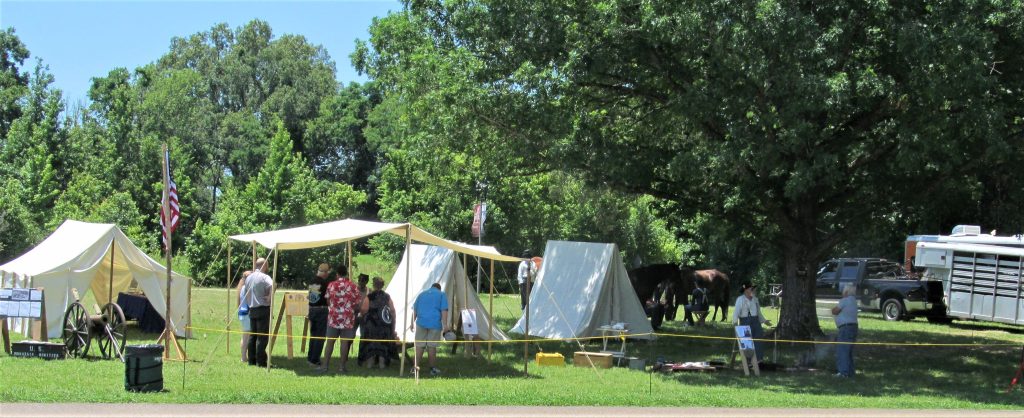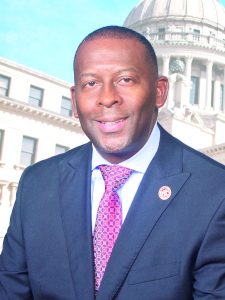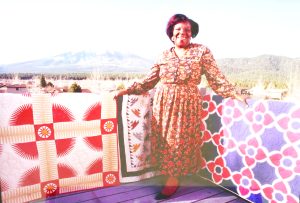On June 7 and 8, 2024, enactors of the Civil War’s 3rd United States Colored Cavalry Regiment (now based in Florida) encamped at Vicksburg National Military Park (VNMP). They presented an “immersive experience” with the only Black Cavalry Regiment recruited in Mississippi, at Vicksburg in October 1863.
Initially organized as the 1st Mississippi Colored Cavalry (African Descent), the designation was changed to 3rd United States Colored Cavalry on May 11, 1864. The unit was assigned to missions in Mississippi, Louisiana, Arkansas, and Tennessee before it was disbanded in January 1866.
After a day of interaction Friday with the troops of the 3rd Calvary Regiment, portrayed by a team of enactors from the Lakeland, Fl.-based Buffalo Soldiers Florida, Inc., local descendants of the actual 3rd United States Colored Cavalry and other interested parties convened Saturday for a late morning and afternoon filming session of interviews and personal critiques for use with the Park Service public programs.
The visitors sat with Michael Schwartz, a National Park videographer. They expressed their views on how the National Park Service can better represent the true story of how Black soldiers and their families helped win the Civil War.
Schwartz grew up in Oklahoma City and attended Catholic schools. He reports learning very little about the historical reality and is curious to learn more. “I did some documentary work for the Park in Natchitoches, LA,” he said. “Learning about sharecroppers and all their struggles was like Slavery 2.0 for me. I had no idea. It was never taught in school. I learned in school that there was slavery and when it ended, everything was hunky dory after that. Which it was not.”
Among the information Schwartz learned from those participating in the “enactment” was that although the Siege of Vicksburg is a classic study in military history, much of its true story has been kept secret from Vicksburg’s African American community for nearly a century. The national cemetery there holds the largest number of Civil War graves of all the nation’s burial grounds. Among those buried there are 7,240 Black troops – 42 percent of the total.
HISTORIC DEPRIVATION
Kevin Hardwick, born in Vicksburg, now age 60, and the great-great-great grandson of 3rd Colored Cavalry enlistee William “Bill” Sims, said he never even had a hint that Black men and women of Civil War era Vicksburg had played a critical role in winning the war. Hardwick said: “I grew up a mile from here and my grandfather was a park employee. But I knew very little about the park other than it was next to where my family lived. Even though it was right there adjacent to our family land, it was still kind of off limits for us children to explore.”
L. Rene’ Hardwick, Kevin’s younger sister, says she also knew of the park because of her grandfather’s work with the park’s maintenance crew. She explained: “But it seemed that the only time we would come to the park was when Aunt Thelma (Sims Dukes) and her son, Zenithe, our first cousin, would come in the summer, and she would make sure that we went to the park. So, it was kind of fun, the structures, the statues, the monuments, but they had no relevance to me as a little Black girl. It was consistent with what we were learning in school, but there was not very much about the Civil War, especially here in Vicksburg. And it wasn’t until the (Black) monument came in 2004 that it became relevant for me.”
Thelma Sims Dukes, the great granddaughter of William “Bill” Sims, said her awakening also came at about the same time in 2004 that the first Black monument was established.
A little-known fact, however, is that two commemorative plaques dedicated to “The African Brigade,” the first 10 USCT Regiments formed in the Mississippi Valley in 1863, were included in the Vicksburg National Park in 1902. But these two plaques, along with 400 others, were melted down because of the metal shortage in World War II. Altogether.
A promise was made to restore the historic plaques and statuary at the end of WWII. While nearly half of the mementoes were restored, the plaques dedicated to the African American troops were not.
It was only after pressure was put on the Vicksburg National Park by Congress to restore the plaques in the late 1990s that one of them was restored. That plaque, however, was placed at Grant’s Canal on the Louisiana side of the Mississippi River rather than in Grant’s Circle in the National Park, where it had been. The VNMP historian at the time reportedly was working in collusion with the late curator of the Old Courthouse Museum to prevent local Black awareness of such mementoes. It is nearly impossible to find the plaque in the woods across the river without specific directions from a knowing guide.
“The first reports on Milliken’s Bend and other articles that were being written about the Black troops participation at Milliken’s Bend and how it helped to win in the capture of Vicksburg across the river from Milliken’s Bend were of great benefit,” Sims Dukes said.
Dukes said: “I understand that the Park is now trying to be more inclusive than when we were growing up and were ignoring the park and everything. It’ll get better. But I don’t want the narrative to start with slavery. I want to know about the nations of Africa and how they were trading with the rest of the world. I don’t want us to start at 1619. If you’re going to tell the story, then tell the whole story.”
TRUTH BE TOLD
Retired American Airlines Captain and Air Force Major Brady Tonth of Vicksburg introduced the theme “Truth crushed to Earth will rise again”. This is a famous line from the classic poem of William Cullen Bryant, and cited by Martin Luther King in his 1957 speech on civil rights.
“And truth is starting to rise again because of people like Thelma, who was instrumental in planting the seed of letting young children know who they are years ago,” he said. “She founded the Buttons and Bows school here many years ago. All her babies at the school learned this. When Black history wasn’t even taught in public schools, she was teaching the little children to know themselves.
“The reason it (our history) was not talked about was because it had to do with white supremacy,” Tonth said. “If you don’t let a people know they are a great people, you can control them more. But if you tell a people they’re no good and trifling, you’re hiding something from them. I don’t take away from the essence of Vicksburg, but it’s bigger than just Vicksburg. If you want to deal with why it’s junked up, you have to deal with the whole story because that’s how people will know who they are.”
PARK EXPECTATIONS
Schwarz told the group that he did not know exactly how the interviews and conversations recorded last Saturday would fit into VNMP future programs. Park Superintendent Carrie Mardorf and Park Chief of Interpretation Brendan Wilson indicated they are anxious to tell the “under told” stories and to perhaps create virtual tours and short documentaries to which people can relate.
Wilson said in an exclusive interview via telephone Tuesday that the VNMP is planning to adopt a new approach to some features of the park and the people who are a part of the park’s reason for existing. He explained: “The Park is committed to a broad range of efforts to bring to light under-told stories of the United States Colored Troops, to restore identity, to tell stories of the occupation and Reconstruction, expand community collaboration and outreach, and develop educational products and programs. One area of particular focus are the stories of those who are buried in the National Cemetery and their descendants. These efforts include the extensive research of NPS Mellon Fellow Dr. Beth Kruse. The NPS seeks the assistance of a broad spectrum of communities, scholars, people, and partners to develop a truly collaborative effort to co-create and tell these powerful stories of the struggle for freedom.”
Also making valuable contributions to the discussions were Jackson State University History Professor Dr. Albert Dorsey Jr.; VNMP consultant on Black life and history, and the author of an upcoming book on the Vicksburg Massacres of 1874 and 1875; Jackson Municipal Judge the Honorable June Hardwick, the youngest sibling of Kevin and L. Rene Hardwick, all great-great-great grandchildren of 3rd Cavalry enlistee William “Bill” Sims; retired Army Major Dr. Kerry Young, a minister at Greater Grove St. M.B. Church in Vicksburg; and Melba Jennings, a long time employee with the Vicksburg Visitors and Tourism Bureau and a VNMP volunteer.






